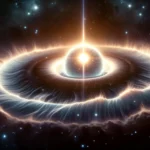The Influence of Massive Stars on Emerging Solar Systems
Recent studies have illuminated the significant role that massive stars play in shaping the formation of planets within solar systems. Using NASA’s James Webb Space Telescope, scientists have observed the dispersal of gas in protoplanetary disks, which are vital for planet formation, by the powerful ‘winds’ emitted by massive stars. This process, observed around a young star known as T Cha in the Orion Nebula, demonstrates how the intense far-ultraviolet (FUV) radiation from these stars can erode planetary disks and inhibit the formation of Jupiter-mass planets by stripping away crucial matter.
The Fate of Protoplanetary Disks
Protoplanetary disks around young stars are the birthplaces of planets, consisting of gas and dust that coalesce over millions of years. However, the proximity of these disks to massive stars, emitting high levels of FUV radiation, can dramatically alter their evolution. This radiation can cause photoevaporation, where the gas within these disks heats up and escapes into space, leading to a significant reduction in material available for planet formation. This process has been vividly demonstrated through observations of the disk around T Cha, showcasing the dynamic interactions that dictate the architecture of solar systems.
Implications for Solar System Formation
The findings from studies on the effects of massive stars on planetary formation provide crucial insights into the diversity of solar systems and the conditions necessary for planet formation. Understanding these processes helps scientists piece together the complex puzzle of how our own solar system, with its unique composition of rocky and gas giant planets, came into being. As research continues, the mysteries of planetary formation and the cosmic forces that shape them become ever more entwined with the influence of massive stars.






